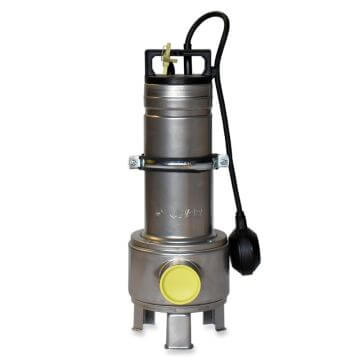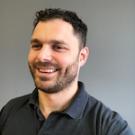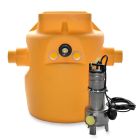Help & Advice Articles, Videos and How-to-Guides
Filter Articles

How to install a foul water pumping station
If you have a basement or below-ground structure that includes a kitchen, bathroom or toilet, then you need to install a foul water pumping station. These pumps prevent the build-up of wastewater and help ensure that the basement is a liveable space. They’re an important component in a drainage system that should be installed correctly so that there’s minimal blockage or spillage risk.
You should receive full installation instructions when you purchase your foul sump system, but sometimes these can be hard to follow. At Permagard, we’re all about removing the jargon and making projects easier. So we’ve simplified the foul pump station installation process below, as well as any key considerations.
What is a foul water pump?
A foul water pump collects and pumps waste and grey water (from appliances or plumbing that isn’t connected to a toilet) out of basements to the nearest drainage point. They’re usually installed in below-ground structures that have bathrooms or kitchens fitted, or even basement conversions that are used as utility rooms.
Wastewater can accumulate in these areas, and if there’s nothing in place to prevent this build-up, then it can lead to flooding and blocked pipes.
Foul pumps can be confused with sump pumps, but they’re two different things. Sump pumps are used as part of a Type C drainage system and help push groundwater towards a drain. Foul stations are not designed for use in these systems and shouldn’t be used in replacement of a sump. You can read our guide to sump pumps here or browse our foul and sewage sump pump range.
Who is responsible for installing a foul water pumping station?
Installing a foul pump system isn’t generally a DIY job. There are a few steps that can be complex, depending on your skill level, so it’s recommended that the pump is installed by a professional. You’ll also need a qualified electrician to connect the station to the mains.
If you do have a lot of DIY experience then you can try installing a foul pump yourself, but make sure to carefully follow the installation instructions if you do - both those provided in this guide as well as those that come with your pumping station.
Your foul pumping station also needs to be maintained and regularly serviced, as per regulations. Sludge and grease can build up over time and cause issues, so you need to check in regularly and make sure pipes and fittings are in working order.
How does a foul pump station work?
A foul pump station consists of a pump that’s housed within an HDPE chamber and connected to the mains electrics and the sewage system. When wastewater enters the chamber and reaches a certain level, the pump discharges the waste through connected pipes to a drainage point and away from the property.
Foul water pumping station design
The design of a foul water pumping station can vary depending on the manufacturer. For this guide, we’re focusing on the PermaSEAL Foul Sump Station.
This station comes with a HDPE chamber and a D10SA vortex foul water pump. The internal pipework is pre-glued, and both the external outlet and cable inlet are already connected - all for easier installation. You can also purchase an AlertMaxx2 High Level Alarm separately for high water levels.


How to install a foul water pumping system
As with the design, the installation process for your pump will depend on the make and model. As mentioned, we’re breaking down the instructions for the PermaSEAL Foul Pump in this guide - make sure to check the guidance that comes with your own station before installing.
1. The base / reinforced concrete box
The foul pump sits within a reinforced concrete box (RC), which you need to construct before installing the pump itself.
The location of your RC and pump is important - it needs to be somewhere that’s accessible for servicing and protected. Create a hole for the RC with dimensions of 1200mm x 1200mm and 800mm depth. Make sure it’s no more than 500mm below floor level.
You then want to install the 110mm inlets. These make a cage-like frame in which you can pour concrete around to form the concrete box. You then need to install the discharge pipework, which should protrude inside the box by at least 100mm.
Once you have this structure in place, then you can pour in the concrete and form your complete RC box.
2. Installing the foul sump chamber
Before placing your chamber into your RC box, first saw off the ends of the sockets on the outside of the chamber so that you can connect the inlet pipes later. These all come with your pumping station.
Once you’ve placed the chamber inside the RC, push the coupler (provided) onto the socket ends and fix the inlet pipes to the chamber spigot. It’s these pipes that will connect the chamber to the sewage system.
After this, you can connect the discharge and vent pipes, and cable duct. This is all done using the corresponding male irons that come with your foul pump. Apply glue to the first 20mm of the external face of the pipes and cable duct and the inner side of the irons. You can then just push them into place.
When all the pipework is connected, fill the chamber with water to help keep it in place and retain its shape. Then fill the void between the chamber and RC with concrete, making sure that the top concrete slab is level with the top of the chamber so that you can easily access the pump.
3. Installing the pump
Now it’s time to install the foul pump. Make sure to remove water from the chamber once the concrete box has cured, as well as any dust or debris that’s inside. On the pump itself, attach the discharge arm to the corresponding outlet, using your hands to do so.
Slot the DC65 connector onto the end of the discharge arm. Fill the chamber with water roughly halfway and then carefully place the pump into the container. Connect the DC65 to the internal manifold pipe built into your chamber, and screw in place.

If you’re also installing an alarm, you can now connect this as per the guidelines. For the PermaSEAL Foul Pump, refer to the AlertMaxx2 alarm here.
4. Wiring your foul pump
As we mentioned earlier, you must get a qualified electrician to connect your foul pump to the mains, as there are risks when dealing with electricity and water. The electrician will pull the cables from inside the chamber through the cable duct and connect to the mains. Wiring instructions will be supplied with the foul pump for them to follow.
Once installed, a one-metre section of cable should be left coiled inside the chamber once all electric work is completed - this will come in handy when carrying out maintenance checks on the foul pump.
You should now test your foul pump station to ensure that everything is in working order. To do this, you just need to lift the pump float and see if water flows out of the pump. If so, then your station is fully up and running.
Foul pumping station cost
The overall cost of a foul pumping station will vary, depending on the contractor, electrician and the pump itself. You’ll also need to consider whether the installation will be part of a wider project, like a basement conversion.
What you do need to remember is that a foul pump is key to creating a liveable space in your basement or cellar. It ensures that wastewater is properly transported away from your property instead of clogging up pipes. So when looking into costs, keep the value of the pumping station in mind.
You can see our low trade price for the PermaSEAL Foul Sump Station here.
Basement drainage and waterproofing from Permagard
At Permagard, we offer all the components for basement waterproofing systems, including foul pumps and sewage sump pumps, which are used as part of Type C systems.
If you have any questions about your project, get in touch with our technical team on 0117 982 3282 or email us at [email protected]. Browse all sump pump systems here.

